What do Slack, Zoom, and HubSpot all have in common? They’re all software, right?
Yes, but that’s not all. These three companies are pioneers in the product-led growth era of software growth marketing.
These companies can scale quicker and more effectively by leveraging the value and customer experience ingrained in their products to create a wave of demand worldwide.
In the past, we thought of these companies as going “viral.” But, the question is, why did they have exponential growth? How did they flip the switch on virality and generate massive consumer interest?
The answer is product-led growth, or PLG — a new era of software growth.
In this article, you’ll learn everything you need to know about product-led growth, including what it is, why it’s important, and how it works. Plus, you’ll see a few examples of companies that have successfully scaled using a product-led growth strategy.
What Is Product-Led Growth (PLG)?
Product-led growth (PLG) is a software business strategy where revenue is spearheaded by the product itself. PLG principles allow a business to drive customer acquisition, expansion, and retention by aligning different departments.
This growth model is built by bringing different teams together — from product development to sales to marketing to customer support — and connecting them closely to the product to create scalable and sustainable business growth.
Product-led growth is a relatively new concept. It’s only a few years old. But, the principles of PLG are centered around a common goal: to create a product-first, user-first experience growth engine around a SaaS product rather than a sales or marketing-first approach.
A Brief History of Product-Led Growth
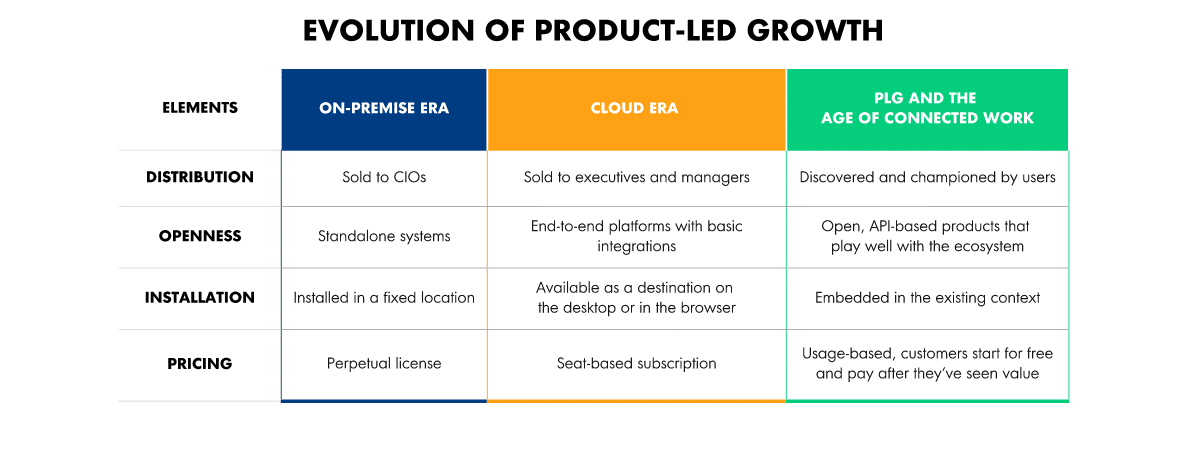
1. On-Premise Software (1980s/1990s)
Flashback to the 1980s. What was software like back then? Well, it wasn’t available to everyone since the internet was still in the early stages of development. Instead, software was something that you had to install from a physical box.
Mammoth-like machines had to be built on-site for hundreds of thousands — and sometimes even millions — of dollars.
To sell these six and seven-figure machines, businesses would depend on sales-led growth. Field sales reps would hard-sell buyers after spending plenty of time schmoozing with them at dinners and golf courses.
The main thing buyers had to worry about was whether the software was compatible with their current IT infrastructure.
2. Cloud Software (2000s/2010s)
At the turn of the century, we started flying high up into the cloud. Salesforce was one company that pioneered software outside of data centers and into the cloud. On-site software transformed into on-demand software. Development costs shriveled up and software became much more accessible to the rest of the world.
Software was finally able to be quite compatible with nearly any business setup. So, outbound sales teams didn’t need to meet with super techy executives anymore. They could reach out to execs and talk about KPIs and ROI to see how certain software would help them reach their goals.
Marketing-led growth drove this era. New terms emerged like sales development representatives (SDR) and marketing qualified leads (MQL). Inbound marketing transformed the way customers found companies to fuel demos and inside sales.
3. PLG Software (2020s)
In the early 2020s, product-led growth began taking over. Now, users have begun embracing workflows that are fully integrated and fueled by automation.
The interconnectedness of different software, combined with the rise of APIs, AI, and automation, has led to this new era called “product-led growth,” which was coined by OpenView’s Blake Bartlett in 2016.
Product-led growth was born out of the power of user experience. With software so accessible nowadays, the need for marketing and sales-led growth began to slow, while the need for the product’s performance accelerated.
Examples of PLG Companies
To help you understand more of how PLG companies succeed, take a look at some of the most popular product-led companies in the world:
Slack
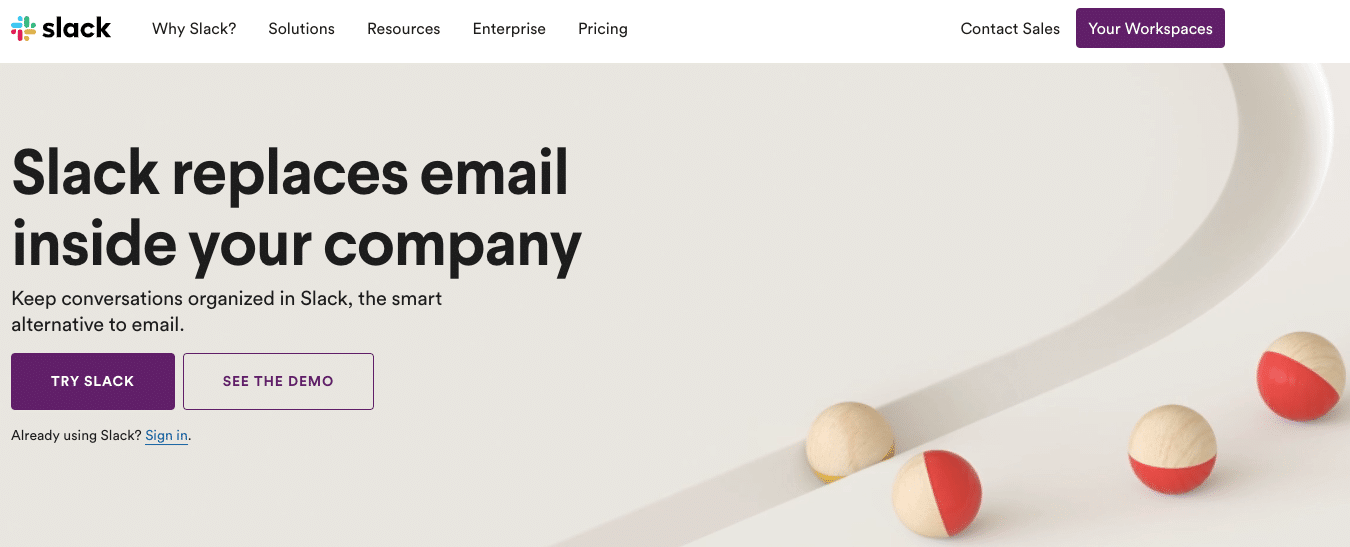
Slack is one of the prime examples of what it means to be product-led. By taking advantage of the network effect, Slack could accelerate its growth.
The company tapped into a type of virality once early adopters began convincing co-workers to hop aboard. Slack began upselling to a paid subscription by convincing users to store their complete messaging history, which was crucial for large companies.
Dropbox
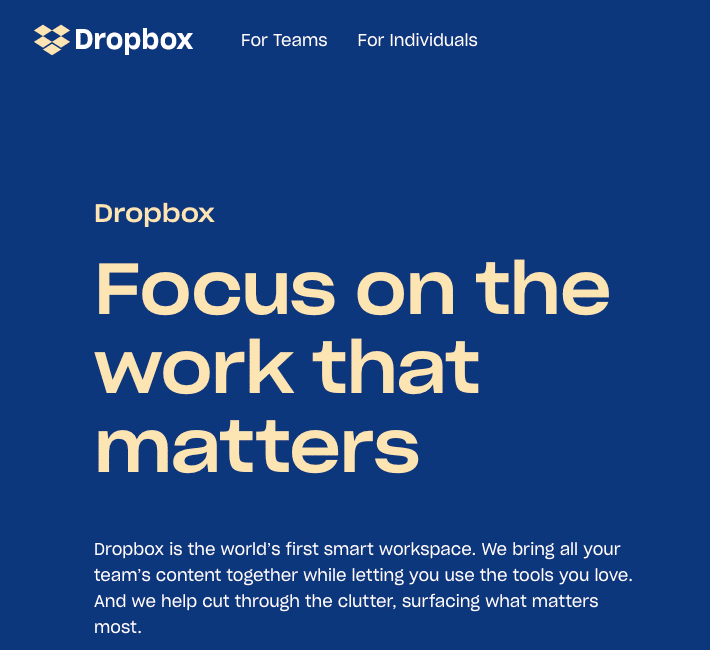
Dropbox is another great example of what it means to tap into growth through the product itself. Dropbox makes it super easy for users to share folders and links with their friends and co-workers, even if their colleague doesn’t have a Dropbox account.
This meant every time a Dropbox user shared a folder, the opener would become a user of the product without even signing up. But plenty of these users signed up after seeing the value of the platform.
Dropbox’s referral program allows users to gain additional storage space for every referred user. This also encourages new people to sign up to try, fueling their PLG strategy further.
Notion

One of the keys to leveraging PLG is by making it easy for people to use the product. Notion makes it super easy for new users to start by offering free templates on their platform. They also offer webinars and tutorials to educate users on Notion’s different tools.
HubSpot
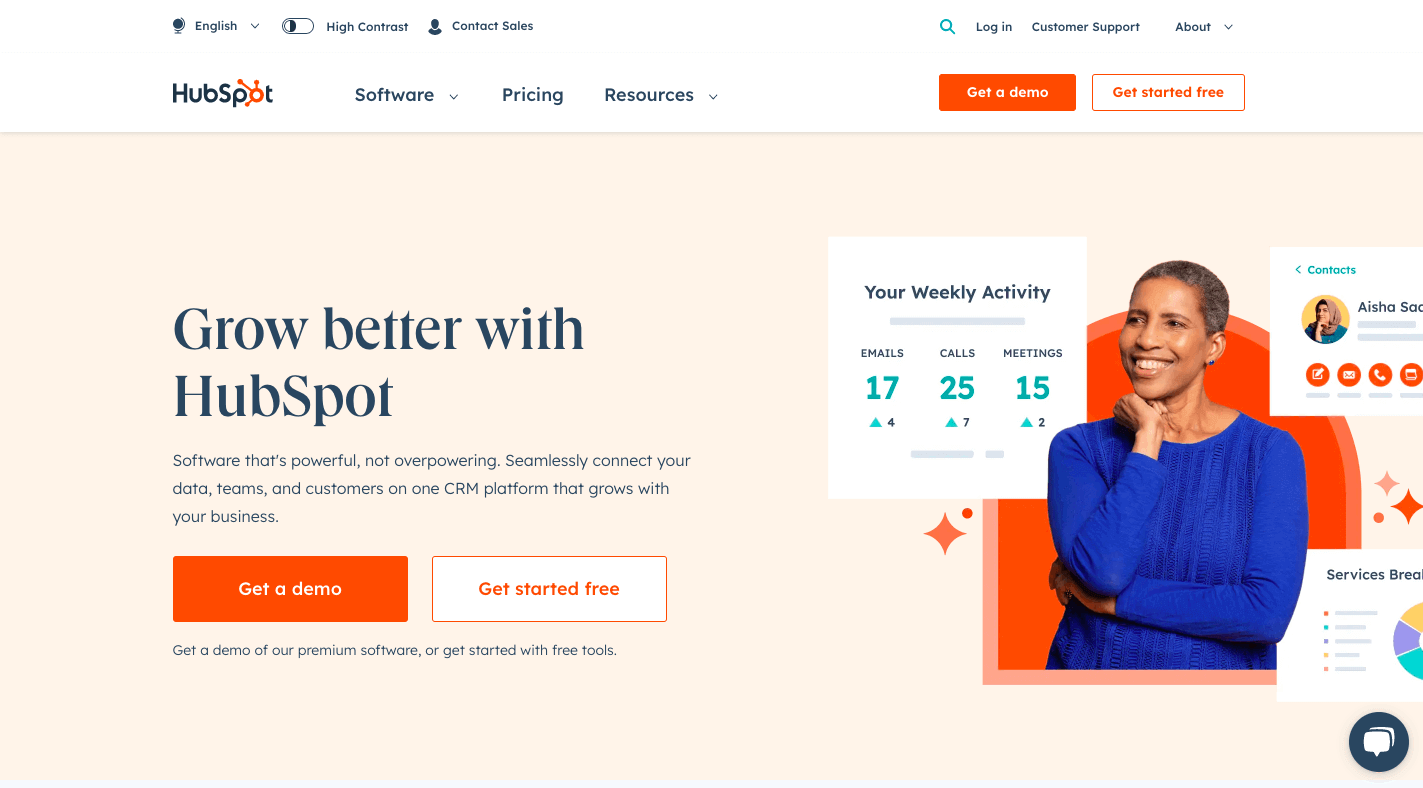
HubSpot is another product-led company that strategized by offering a sales team and customer success team for freemium users. This additional support early on enhanced the user experience, allowing plenty of product education early on which fueled signups.
By leaning on segmentation tactics, the team could invest its resources (primarily their teams) into qualified leads. By investing plenty of their money into support and resources, they could enhance their product to fuel growth.
How Does PLG Compare to Other Growth Models?
Product-led growth is the new era of growth for SaaS and software companies. However, many companies are still using other growth models, such as sales-led growth and marketing-led growth. Here’s how the different growth models compare.
Sales-Led Growth
Sales-led growth is pretty straightforward. It’s companies whose primary growth efforts are driven by their sales teams. Everything the company does supports its sales department. Major and minor decisions in every department filter actions through one question, “Does this help our sales department convert more buyers?”
But guess what? 53% of buyers prefer to make a purchase without any interaction with sales teams!
Marketing-Led Growth
Another common growth methodology is called marketing-led growth. Companies who employ this strategy focus on supporting their marketing team in every decision to help convert more leads into customers.
While sales teams still have their roles in closing deals, the marketing team is primarily driving growth through different advertising strategies and customer research.
In industries where products and software are similar, it’s often the marketing teams who make the difference in what company will drive more revenue.
Product-Led Growth
In both of the previous models, the prospective buyer has to be sold on the value of the product they’re thinking of purchasing. Alternatively, product-led growth is all about prioritizing the product to let its value speak for itself.
Rather than investing heavily in marketing teams or sales teams, product-led companies invest primarily in product development. This doesn’t mean the sales or marketing teams aren’t active.
Their primary goal is to convince prospects to try the product immediately through the freemium subscription model. By getting prospects into the door to become users, the product is designed to allow users to experience the value firsthand to reveal its true value and persuade them to continue using it, with many choosing to upgrade to a paid plan.
What Is the Importance of PLG?
Product-led growth is a necessity for any software company in the modern age. Companies don’t hold the keys anymore. Instead, they’re in the hands of the consumer. Hard-selling customers and deploying marketing tactics to fuel growth isn’t enough to convince a person in the digital age to become a customer.
The power is finally in the hands of the end user, which means the best product will win.
Here are a few reasons why PLG is a crucial strategy for SaaS and software companies to use today:
1. Improved Customer Experience
When you implement PLG, it means honing your product to make it superior in the marketplace. A major part of the process is focusing on customer experience. This means designing the product with the end user in mind.
It’s not just about features. It’s about how those features interact with one another and the end user in an enjoyable way. Oftentimes, this means tightening up the timeframe between the first interaction with a prospect and the moment they begin using your product.
2. Better Acquisition
When you’re heavily focused on your product development, it means improving the user experience. The result? You’ll acquire more customers.
PLG means your acquisition is built into your product through free trials and signups. This lower barrier to entry means you can save plenty of money from sales and marketing efforts that can be spent to encourage even more acquisition through the product experience.
3. Faster Growth
When you let your prospects try your product for free, you reduce the roadblocks for them to eventually become paying customers. This friction-reducing event means you can drive huge user signups, which can be funneled into your conversion pipeline.
4. Greater Company Valuation
Perhaps the most important reason PLG should be implemented in your business is because of the value it offers to your company. Product-led growth companies are more valuable. This isn’t just our opinion. It’s backed by data.
According to OpenView Partners, product-led companies are 30% more valuable than those who aren’t product-led.
Essential Product-Led Growth Principles
Now that you know what product-led growth is and why it’s important for businesses to implement it today, let’s take a look at some of the key PLG growth principles.
1. Start With the End User
The core foundational principle of PLG is to start with the end user. Everything in your business is all about your target audience. By staying obsessed with delivering value to the end consumer, you’ll fuel product development which will serve the consumer.
2. Create Products That Live Where Your Audience Lives
It’s not enough to create a great product. You have to build your product where your audience lives. This means ensuring you’re doing everything you can to make your product accessible or even usable in the places your audience already is. This means allowing your product to integrate easily into the places your audience lives and works. The easier it fits into someone’s workflow, the more likely they are to adopt it.
3. Build Open Source
Let your product be driven by APIs. Make it open-source so it’s accessible, customizable, and easily integrated into workflows. This will make your product valuable to more people.
4. Design for Flexibility
Flexibility is a key function of PLG. Your product needs to be flexible to the end consumer. Give them the tools and features they need to customize the product to their unique needs to provide more value.
5. Build Community While Building the Product
Your product is nothing without community. While you’re developing your product, develop your community. A community shouldn’t be added on.
It should be part of the product, built into it. And your product should be built into the community.
This will cultivate ownership in your brand and create superfans who will drive growth through brand evangelism.
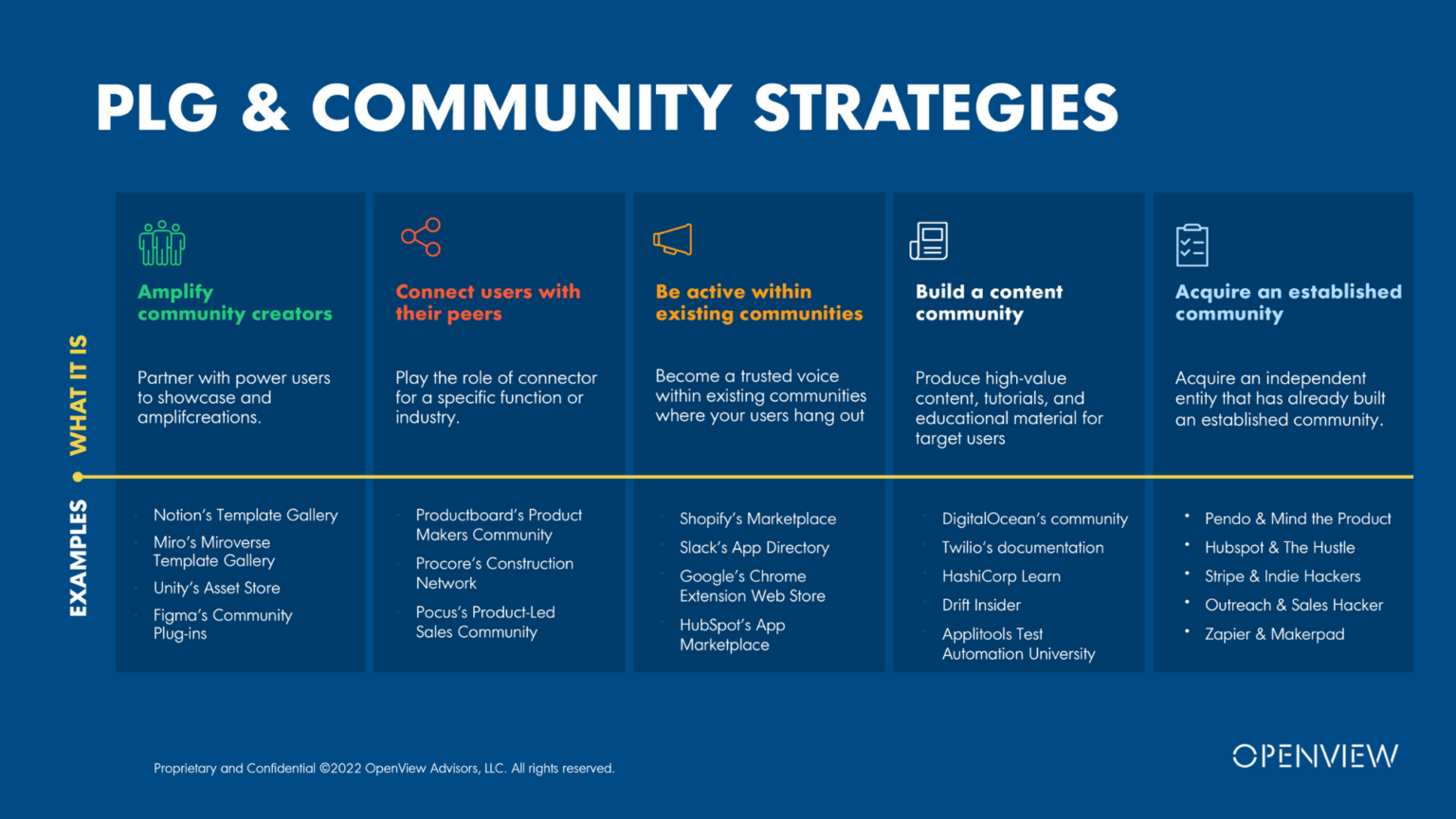
6. Deliver Value Before Asking for Payment
This is one of the pillars of PLG. It’s crucial you offer value upfront before asking your prospect to hand over their hard-earned cash. By offering your product in the freemium model, you are taking on the risk so the consumer doesn’t have to.
This means there’s less risk for them, which reduces friction and makes them less hesitant to try it out. By reducing the barrier to trying your product, you’ll encourage more users to get their hands on the product, which will fuel premium user conversions.
Unsure how to fairly price your product? Check out this product pricing guide.
Product-Led Growth Metrics
Now that you understand why PLG is important and the core principles to lean into the strategy, it’s time to look at how you can tell whether you’re on track or not.
Here are a few of the most common product-led growth metrics you can use to ensure you’re making progress.
1. Time to Value (TTV)
The amount of time it takes new users to hit their first activation event. For instance, signing up for your product isn’t necessarily a TTV event.
Most likely, it’s when more points of action occur, such as importing customer data, integrating another tool, inviting a friend, or completing a user onboarding sequence.
The goal for this metric is to reduce it as much as you can. The closer you can get to zero, the better. Many SaaS products have a long TTV. However, you can speed up the process by focusing on optimizing your user onboarding experience to drive activation.
2. Product-Qualified Leads
While marketing–qualified leads (MQLs) are a standard type of lead measured by marketing teams, product-qualified leads are those that have experienced your product’s value already. This typically means users who have a freemium or free trial account.
Your definition of a PQL will differ depending on your company and goals. However, it’s often the warmest type of lead you can pass on to your sales team.
3. Feature Adoption Rate
Another core metric you should consider tracking with a PLG strategy is feature adoption rate. While product adoption rates are commonly tracked in product teams, a key metric for PLG is feature adoption.
This rate, measured by a percentage, shows how many people are using each feature of your product. You can gain key insights from this data to fuel your product development and drive user growth.
For instance, you may find that a new feature you introduced has a high adoption rate which has fueled your overall product adoption to increase.
4. Expansion Revenue
This is a crucial metric you can use to track your sales growth. PLG seeks to offer value upfront to the user. However, it doesn’t end there.
The goal is to provide enough value that a percentage of free users eventually upgrade to a paid plan. Additionally, you can drive revenue through further upgrades, upsells, add-ons, and cross-sells.
Expansion revenue looks at revenue generated from existing customers.
Is a PLG Strategy Right for Your Business?
How do you know if product-led growth is the right strategy for your company?
Before you dive into the strategy, it’s important to consider what type of business will find product-led growth most attractive.
Overall, PLG works best for SaaS business models. Additionally, it works great for businesses with affordable price points and more transactional sales.
If you own a SaaS business, then take a look at these three considerations: markets, resources, and product readiness:
1. Markets
The first consideration you need to look at is to look outward at the market and the competition.
Ask yourself:
- Is there a product-market fit?
- Is there a growing market?
- Are there underserved consumers?
- Who are my competitors?
- What are their strengths and weaknesses?
- How much will it cost to acquire a customer?
2. Resources
If you see that there is an opportunity in your market to make your product a success with PLG, then move on to resources. You need to have the right culture and mindset to make this strategy work led by product development.
Ask yourself:
- Do I have the right talent?
- Can I convince my team to use this model?
- Am I willing to invest time, resources, and money to track PLG data?
- Can I justify the business investment into these resources?
- Where will I sacrifice to invest in PLG?
- Do I have the right marketing expertise to execute PLG?
3. Product Readiness
Finally, if you’ve assessed that the market is ready and you’ve got the resources to make it work, it’s time to assess your product’s maturity.
Ask yourself:
- Is my product intuitive?
- Does it solve the target audience’s problems?
- Is it easy to use?
- Does it have competitive features?
- Is it unique enough in the marketplace?
- Is the product reliable?
- Is it scalable to handle increased use?
- Can my audience realize product value fast on their own?
- What sets us apart from the competition?
Product-Led Growth FAQ
Still curious about product-led growth? Here are answers to some of the most common questions:
What Challenges Can Arise When Using Product-Led Growth?
There are two main challenges that occur with PLG: the first is getting your entire team on board with this growth strategy centered around the product vs. the marketing and sales teams. The second is understanding data. It can be challenging to understand how your PLG efforts are working, which is why it’s important to lean on PLG metrics like time-to-value, product-qualified leads, and feature adoption rate.
Product-Led Vs User-Led Growth: What Is the Difference?
User-led growth relies on user insights to create the best customer experience. Product-led growth leans on the product experience to drive revenue growth. These two models don’t compete. They should be used together. You should create an amazing product, ask users for feedback, then use that feedback to improve the product.
What Is a Product-Led Culture?
A product-led culture is one that hones in completely on the product and the value the product offers to the end user. It means every department first thinks about how their actions will improve the product to create the best product possible.
Summary
If you’re looking to start implementing a product-led growth strategy, the easiest way is to begin focusing intently on your users. Do a deep dive into your current users. Learn how they navigate your product and what they like and don’t like so you can optimize the product experience.
And, if you need a partner in growth, give Kinsta a try. At Kinsta, we’re obsessed with site speed. On average, our customers see site speeds increase by 20% by simply migrating to our hosting service.
At Kinsta, you can get all your database, applications, and WordPress sites online and within one hosting solution. Get started today with a free trial of our Database Hosting or Application Hosting today!


